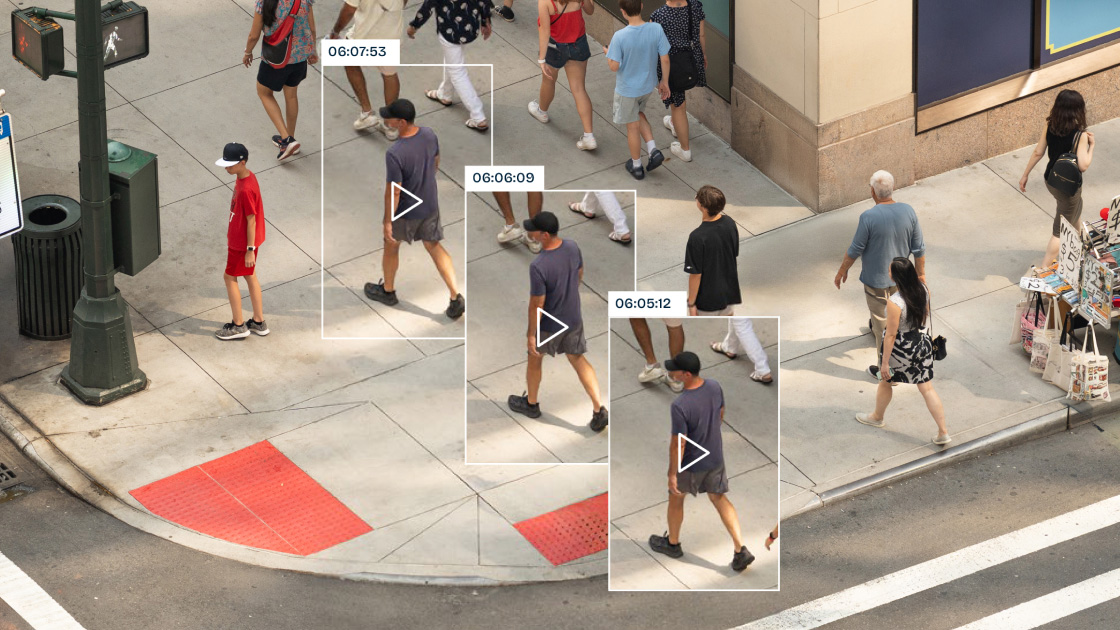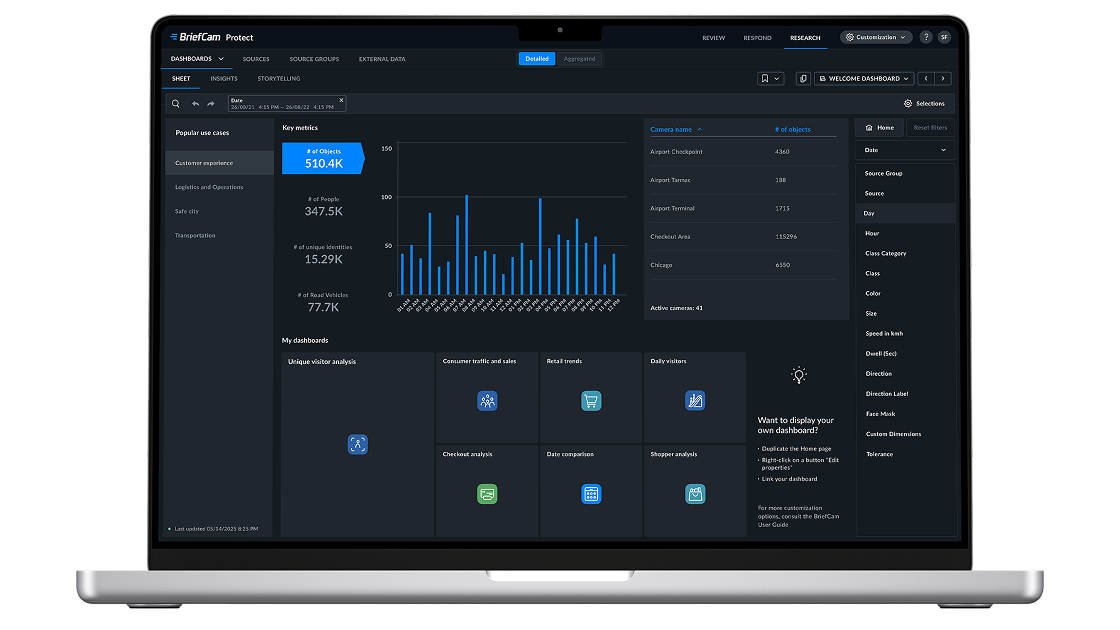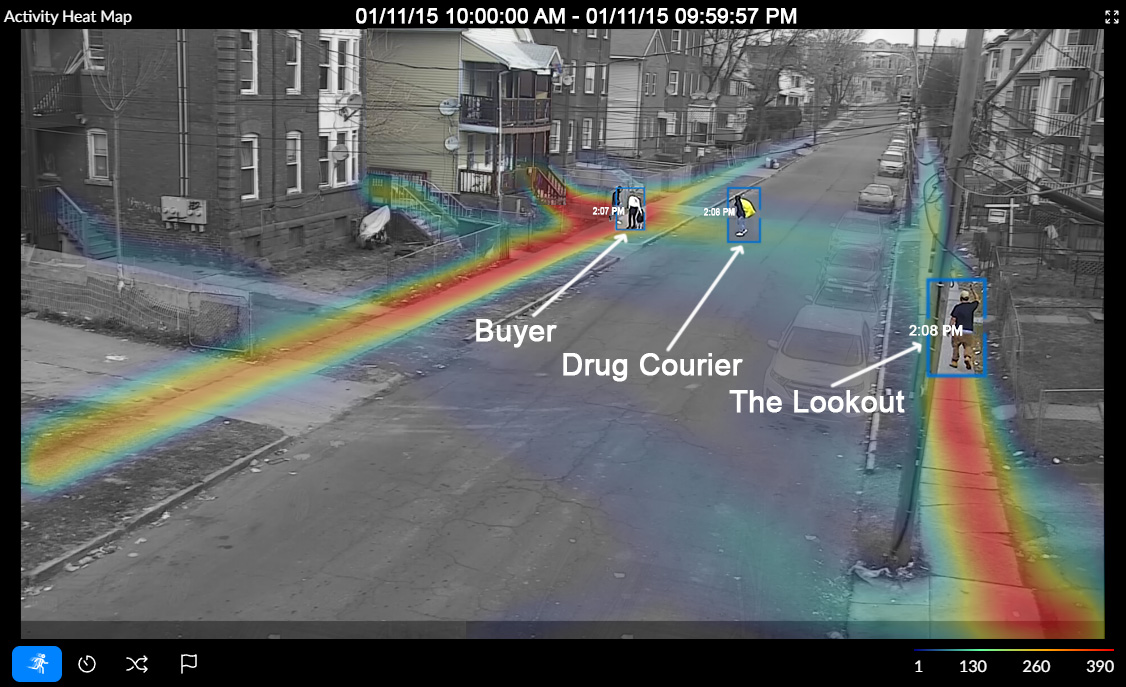In our “Intro to BriefCam” webinar, we asked 1,500 people to send us their questions. This article brings you the full webinar recording and Q&A (including the questions we didn’t have time for on the day of the webinar).
If you have a small site and very few cameras, edge analytics might be enough. Once you have dozens or hundreds of cameras with different brands and models, then you start needing a more robust system of analysis. It’s most likely going to be a centralized or server-based solution. But how do you know if a VMS is sufficient or if you also need BriefCam?
The most important difference is that BriefCam can analyze vast amounts of video data faster than any video management software could on its own. Most customers invest in BriefCam after an incident that was time-consuming to investigate, or after an audit that revealed other inefficiencies (e.g., theft, poor customer experience due to insufficient staffing) that analytics could solve.
Another key difference is that many VMS add-on analytics only work for specific licensed cameras. With BriefCam, you get license plate recognition, facial recognition and other advanced analytics across all recorded footage without needing per-camera licensing. But BriefCam doesn’t do the actual recording; that’s the job of the VMS.
While BriefCam is widely used in security and law enforcement, it’s also highly effective in operational and business intelligence applications. Organizations use BriefCam to understand movement patterns in public spaces, analyze foot traffic and improve safety—even outside of typical security environments. For example, cities use it to evaluate traffic flow or pedestrian behavior, and retail businesses apply it to optimize store layouts and staffing. This is where our “Research” module really shines.
Yes, BriefCam includes license plate recognition (LPR) and face recognition features. You can filter search results using license plate numbers, vehicle make and model. You can search based on vehicle and facial attributes and even set alerts for specific plate numbers or, say, prohibited individuals.
We got a question about the reflectivity of U.S. license plates. BriefCam uses a combination of techniques to address reflectivity of license plates in LPR scenarios, including deep learning, vehicle tracking and optimal frame selection.
You can disable the face recognition as well as license plate recognition in BriefCam if you need to do so to comply with local privacy laws. It's also important to understand that BriefCam doesn’t actually recognize anyone; it’s not connected to any database or anything like that. Instead, BriefCam scans video data looking for matches of a face that you’ve specified.
Not yet. We can detect objects and people; we can know what direction they’re going in, what they're wearing and so forth. But we don't do emotion detection. We can match faces even if someone is wearing a face mask or a hat. But we don't know if they're happy or aggressive. The same applies to gestures; that’s not available yet. Milestone’s XProtect Hospital Assist add-on has fall detection, but that’s not something available with BriefCam yet.
BriefCam doesn’t have these capabilities baked into the platform, but it does integrate with VMS and other technologies (e.g., sensors) that can do smoke and fire detection.
Yes. BriefCam utilizes AI algorithms to analyze video feeds and identify various anomalies, including baggage left unattended in public spaces like airports.
As long as the feed comes into BriefCam and we can process it, it doesn't really matter where it comes from. We even have customers who process footage from drones.
Officially, all of our documents say a static background is needed, which isn’t the case with drone footage. However, we have customers using drones where object recognition, LPR and face recognition still works. Video Synopsis, speed and direction generally won’t work as they rely on a static background.
BriefCam can do both. For real-time alerting (like detecting vehicles in no-parking zones), the Respond module offers live monitoring capabilities. For forensic investigation and pattern analysis, video can be processed after the fact using our patented Video Synopsis® technology (available in the Review and Research modules). It condenses hours of video into minutes by overlaying moving objects captured at different times.
In this scenario BriefCam would communicate with the VMS using an API or SDK. There would be a security operations center monitoring footage with alerts synced between BriefCam and the VMS. With BriefCam, footage can be taken either directly from the camera or the archive process. But in a live monitoring scenario, it would be communicating directly with the VMS over the local network.
BriefCam Respond alerts can be sent back to the VMS using native, ONVIF eventing or via REST API/webhooks. These alerts can include video annotations like bounding boxes and snapshots, which appear in the VMS as tagged or bookmarked events. This allows operators to view annotated footage and respond quickly from within the VMS. The integration ensures real-time alerting with contextual video evidence directly tied to the alert.
While it doesn't directly transcribe videos into text, it can analyze video content and create structured databases of information. This structured data can be used for granular searches, reporting, and alerting based on video content, essentially making the video searchable and actionable.
Yes. Case management (part of the Review module) lets you organize all video assets of an investigation in a single container, bookmark objects of interest and export case findings reports to support collaboration.
Everything can be processed centrally. It all comes down to bandwidth and what kind of pipe you have from where the cameras are back to the BriefCam server. If it's data intensive, if there are many high-resolution cameras and the pipe is small, then we’d most likely suggest BriefCam Nexus where there's a central server and then you have a hub at each site processing the video locally, and then just sending the metadata back centrally. But if you have a big enough pipe and the requirements for processing are on the lower end, then you can stream everything back centrally.
Not yet. Currently, the type of AI that BriefCam incorporates has to do with neural networks, identifying objects, tracking them, classifying them, etc.
BriefCam can be integrated with all industry-approved VMS products including, of course, our very own XProtect. It can also be used as a standalone product, which we’ve most commonly seen within law enforcement. Police investigations can involve pulling video files from many sources: home systems, business security cameras, traffic cameras, etc. The standalone version of BriefCam can analyze all of this without being connected to a VMS. That said, most customers use BriefCam together with at least one VMS.
BriefCam supports the standard codecs H.264, H.265/HEVC, MPEG-4, H.263. There can be issues if the files are corrupted or incomplete, but even in these cases we’ve seen processing work.
BriefCam can work with analog cameras, even when used with encoders at existing sites. BriefCam is camera agnostic and can process video feeds from various sources, including analog cameras, as long as the resolution and frames per second (FPS) requirements are met. Encoders can be used to convert analog video signals to a digital format, making them compatible with BriefCam's processing capabilities.
There are different pricing plans with different modules available, but the Review module is part of all of them. Our patented Video Synopsis technology comes with this module, making it the backbone of your system. Download the BriefCam data sheet for the full list of features available in each module.
They are two distinct but complementary modules in the platform, each with its own rule engine. The Review module is still necessary though because it serves as the core analytics engine that processes video, detects objects and generates metadata. Although Review and Respond have separate rule engines, Respond relies on the metadata produced by Review to trigger real-time alerts. Without Review, Respond would have no analyzed data to act upon. Essentially, Review provides the foundational video analysis that powers both post-event investigation and real-time alerting.
Yes, as long as the hardware requirements are met. The same goes for runnig BriefCam on VMware. As long as the virtual environment has the requisite hardware (Intel CPUs and NVIDIA GPUs), it will work.
Still, most of our customers choose to run BriefCam on-premises. If you book a call with us, we’ll be happy to help you to size the system according to your needs (number of cameras, resolution, how many objects you need to process). You can also choose to buy the hardware from us or from a third party.
BriefCam's analytics can operate both on-prem and in the cloud, meaning it doesn't inherently depend on an internet connection for all operations. However, cloud-based deployments and some features like remote access require a stable internet connection for optimal performance.
One problem that many transport services are facing is fare avoidance. Before deploying more ticket inspectors or police, it’s crucial to first understand where and when it happens. Whether the issue is system-wide or limited to a few stations at certain times will shape the right solution. This data also provides a baseline to measure improvements (e.g., showing a 40% drop in fare avoidance after action is taken). Beyond that, video analytics in transportation can help monitor footfall, manage incidents in real-time, detect luggage and other objects left behind and improve overall transit operations.
The most common reasons we hear from customers in retail is of course keeping employees and inventory safe. That’s the security side with Review and Respond. But there’s also the business intelligence side. You can use the Research module to analyze customer behavior; identify trends and patterns in how people move through and interact with commercial spaces. This analysis can result in optimized layouts, staffing, workflows and operations.
BriefCam primarily focuses on video analytics for surveillance and does not specialize in end-of-line analysis in the manufacturing or production context. What BriefCam can do for this sector is called “Custom Classified” analytics which let customers define, train on-site and leverage custom classes for uniformed workers and 4-wheel vehicles.
Once trained, these custom classes can be used across all BriefCam modules—Review, Respond, and Research—for post-event analysis, real-time alerts and data insights. This enables more tailored and effective monitoring, such as tracking specific equipment, ensuring uniform compliance or detecting unauthorized vehicles. The training is done on-site using sample video footage, making it adaptable to each unique environment. This feature is available exclusively with BriefCam’s Linux-based analytics engine.
Much like the manufacturing sector, one key use case is using custom classes to monitor for PPE compliance, such as detecting whether workers are wearing helmets or reflective vests in hazardous zones. It also supports intrusion detection by alerting when unauthorized personnel or vehicles enter restricted areas like pipelines or refineries. Operational efficiency can be improved by analyzing worker and vehicle movement patterns to optimize workflows and reduce downtime. BriefCam also aids in incident investigation, allowing teams to quickly review hours of footage to identify the cause of safety breaches or equipment failures. Additionally, its real-time alerting and data visualization help support proactive risk management and regulatory compliance.
Yes. BriefCam classifies everything as “objects”, even people and animals. Object detection and tracking is simply a technical term for everything that can be identified; no offence to the living creatures being analyzed.
BriefCam doesn’t change anything on the original file. It simply analyzes it. In court cases around the world, any video evidence (collected by law enforcement or other parties) needs to be proven to be authentic. Most trusted VMS systems have a digital signing system that ensures the videos have not been tampered with. BriefCam simply finds the evidence faster which in turn can help court proceedings (i.e., the court gets the original file plus a note with a timestamp of an incident). BriefCam is used by police forces all around the world, including Canada and the United States.
A police department that does both on-demand (Review) and real-time processing (Respond) for approximately one hundred cameras would need at least two GPUs.
BriefCam does not store any video or personal login information belonging to our customers. However, BriefCam as a product, like Milestone’s XProtect VMS, enables our customers to use surveillance data in a GDPR compliant way.
BriefCam supports secure communication protocols (like HTTPS and TLS), role-based access control, user authentication and audit logging to track user actions. BriefCam can also be deployed in hardened environments, supporting network segregation, encryption at rest and compliance with IT security policies (e.g., password policies, account lockouts).
Additionally, BriefCam often undergoes vulnerability assessments and provides guidance for secure system architecture, especially when integrated with other systems like video management systems or identity management platforms. However, ultimate cybersecurity depends on proper configuration, deployment and ongoing patch management which is the responsibility of our customers.
Speeding up investigations on its own is a cost-saving benefit in terms of work hours. But that’s not the only benefit. You can re-frame BriefCam as an investment instead of a sunk cost. Many customers see a return on investment through reduced theft, increased money from fines based on identifying illegal waste disposal and traffic violations, and better insights for optimizing urban planning and commercial layouts. There are also grants out there to help pay for video security software, such as the COPS grant for law enforcement in the United States.
Yes. BriefCam’s Video Integration API (VIA) is a generic HTTP RESTful request-based plug-in that enables third party integration with BriefCam including real-time (RSTP) video ingestion. If you’re interested in testing it out, please contact us through this form.
Licenses are perpetual, meaning once purchased, they're valid indefinitely. Continued access to updates, patches and support comes via a maintenance/renewal plan, similar to Milestone's XProtect Care Plus. Licensing is calculated based on both features (e.g., only Review or also Respond and Research) and the number of cameras.
BriefCam provides online and/or on-site training depending on the needs of the customer. These generally come at an additional cost, with on-site training being a bit higher.
There are no upcoming Spanish webinars, but if you book a one-on-one demo we’ll set you up with a native speaker to make the most of your time and answer your questions in a personalized way.
BriefCam is compatible with all paid variants of XProtect. The best way to see this in action is to book a demo that matches your needs and interests. If you’re not ready for that yet, then keep an eye out on our website and YouTube channel for upcoming product tour videos. We don’t currently have publicly available pricing, but if you’re an existing XProtect customer wanting a discount on BriefCam (or vice versa), we’d love to hear from you.


